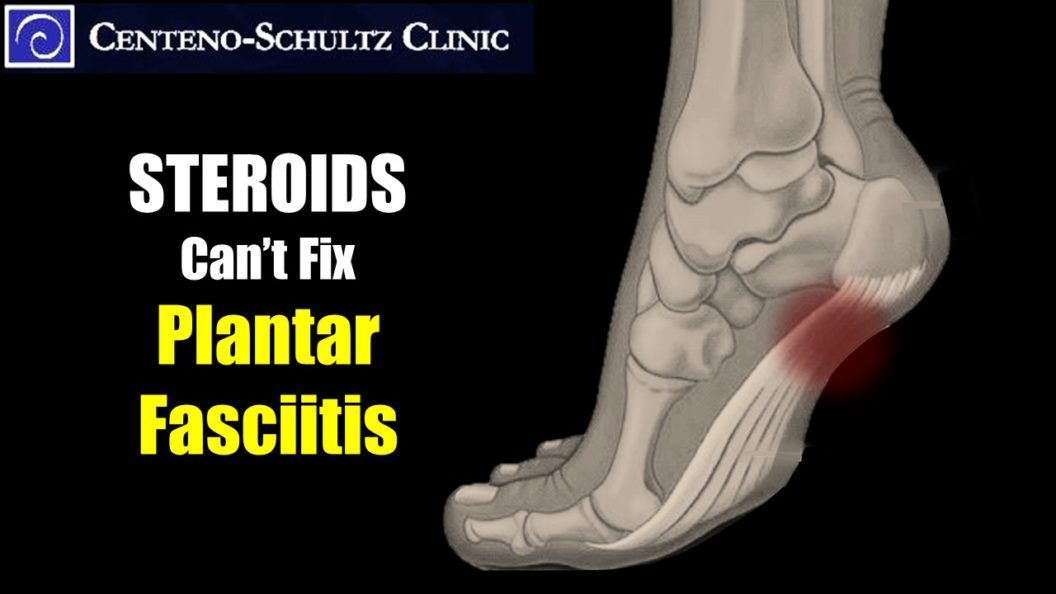Steroids are powerful anti-inflammatory drugs that are injected in high doses to treat conditions that are highly inflammatory and cause pain, such as arthritis, tendonitis, and even plantar fasciitis. To many, after dealing with chronic pain due to inflammation for weeks, months, or longer, the idea of steroids may sound like a miracle relief, and while initially this may seem to be the case, unfortunately, these high-dose steroids come with many nasty side effects that negate their benefits. Let’s take a look at plantar fasciitis and 3 reasons why steroid injections for this inflammatory condition are a bad idea.
What Is Plantar Fasciitis?
The plantar fascia is rake-shaped band of tissue that stretches from the base of the toes and attaches at the underside of the heel. Plantar fasciitis is damage to this structure. Microtears or irritated nerves along the plantar fascia, for example, can cause inflammation and make it extremely painful to walk. If you’ve ever had plantar fasciitis, you know it. The pain is sharp and shooting (often shooting up into the calf) and can seem almost needle-like, especially with those first few steps when you get out of bed.
Oftentimes, plantar fasciitis will heal on its own, but it can be a very lengthy process (weeks, months, or longer) and may require many conservative therapies, such as stretching, ice, rest, orthotics support, physical therapy, and so on. When conservative treatments seem to fail, however, the next step your physician might suggest is high-dose steroid injections.
3 Reasons Steroid Injections Are a Bad Idea for Plantar Fasciitis
You probably already know that steroids are riddled with side effects, but many patients still prefer the risk over the pain. What you might not realize is just how toxic and dangerous steroids really are. You also might not realize that while they seem like a miracle cure in the beginning, their effect fades with each subsequent treatment. Let’s review.
1. Steroids Are Toxic to Cartilage
High-dose steroid injections destroy cartilage. You may know a little about the protective cartilage in your larger joints such as the knee, but your foot also contains many tiny joints, and each of these joints are also cushioned with cartilage. While these high-dose steroid injections may relieve some inflammation and pain temporarily, they are the catalyst for cartilage destruction, which leads to arthritis and other problems down the road. So adding foot arthritis to plantar fasciitis isn’t going to provide the long-term relief you’re looking for.
2. Relief Diminishes with Each Subsequent Steroid Injection
That first steroid injection for your plantar fasciitis may seem like heaven, and you may wonder why you put it off for so long. However, the second will probably not provide the same degree of relief, and the third even less so. Research supports this as well, as it’s shown that repeated steroid injections provide diminishing relief with each injection. Why is this? It could be because of the effect they have on your body’s local healing stem cells (see number 3).
3. Steroids Are Toxic to Stem Cells
Stem cells are the body’s own powerful repair cells that jump into action when an injury occurs. Their job is to heal the damaged tissue; stem cells in the foot, for example, would tackle the damaged plantar fascia. Steroids, however, are poisonous to stem cells; this study, for example, shows how they impact our mesenchymal stem cells, stifling their ability to repair or become bone. So when stem cells become damaged by steroids, they can’t properly repair; when stem cells can’t properly repair, tissue damage progresses. In one study, even smaller doses of steroids than are typical killed all local stem cells.
Steroid injections, while a bad idea, are probably at least familiar to you, but platelet-rich plasma (PRP) injections can also treat plantar fasciitis
PRP Injections for Plantar Fasciitis
Platelet-rich plasma is concentrated from your own blood platelets (natural healing molecules and growth factors), which are obtained from a simple blood draw. The whole blood is spun down, or centrifuged, which separates the plasma serum. The platelets are concentrated in this serum, resulting in PRP. PRP is like a good jolt to your local stem cells, stimulating them to get busy and start repairing damaged tissues, such as muscles, tendons, ligaments, and so on.
One study found that PRP is a more effective treatment for chronic plantar fasciitis than steroids. These researchers found PRP to be not only a safe solution but a longer-lasting solution when compared to steroids – over and above surgery and cortisol injections.
When conservative measures fail and waiting it out just isn’t doing the trick for your plantar fasciitis, please don’t turn to steroids! We only covered 3 reasons these high-dose steroid injections are a bad idea, but if these aren’t convincing enough, there are many more. PRP has been shown to outperform steroids for plantar fasciitis and without all the toxic side effects.

